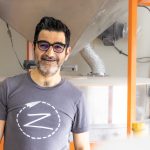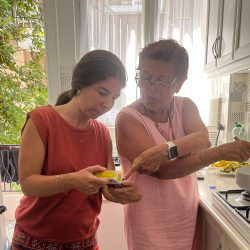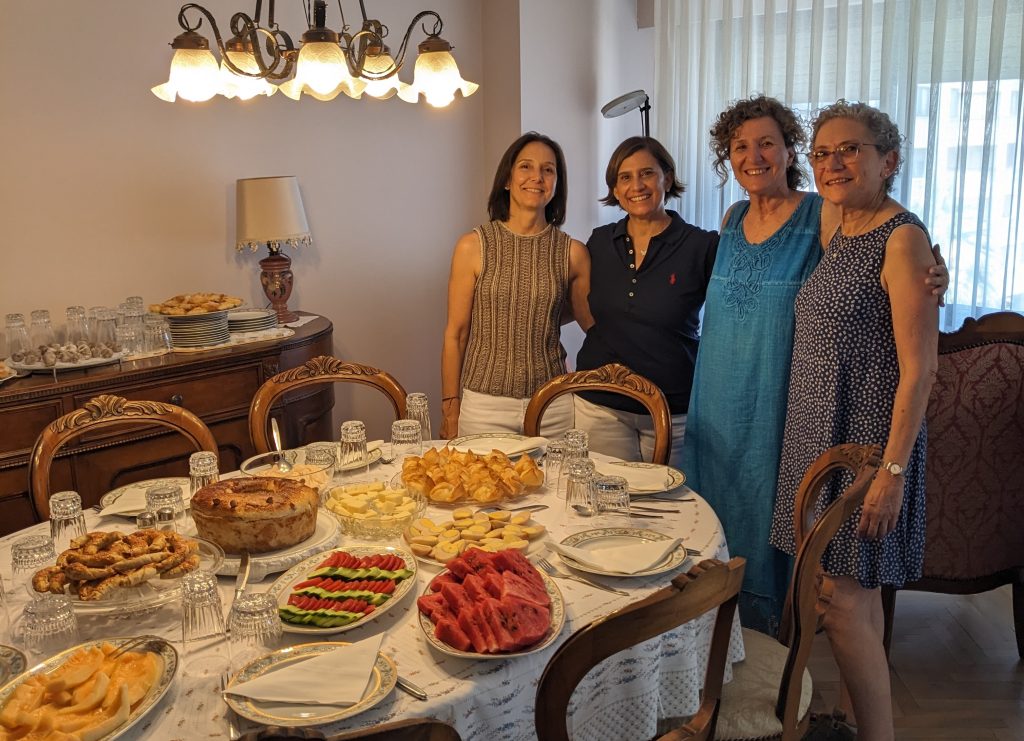
My morning mission was complete after tasting how boyoz, the Sephardic tradition, lived on in the streets of Izmir. Now, it was time to see how it still lived in the homes of Izmir’s Sephardic Jews. So, after a few blocks and turns from our hotel, we walked up some stairs and knocked on Nuket’s door for a cooking workshop.
Nuket greeted us with her friends Katya, Ester, and Lina, who grew up together in the tight-knit Sephardic community of Izmir. Not only that, Ester, Lina and Nuket also co-authored a cookbook titled Izmir Sephardic Cuisine with its lost and existing 100 recipes, a great sign that we were in good hands. We acquainted ourselves over some Turkish coffee and Sephardic treats, including beautiful ribbed almond cookies, crescent moon cookies, and marzipan. One by one, we heard how they ended up in Izmir from the Iberian Peninsula by way of their grandparents and parents.
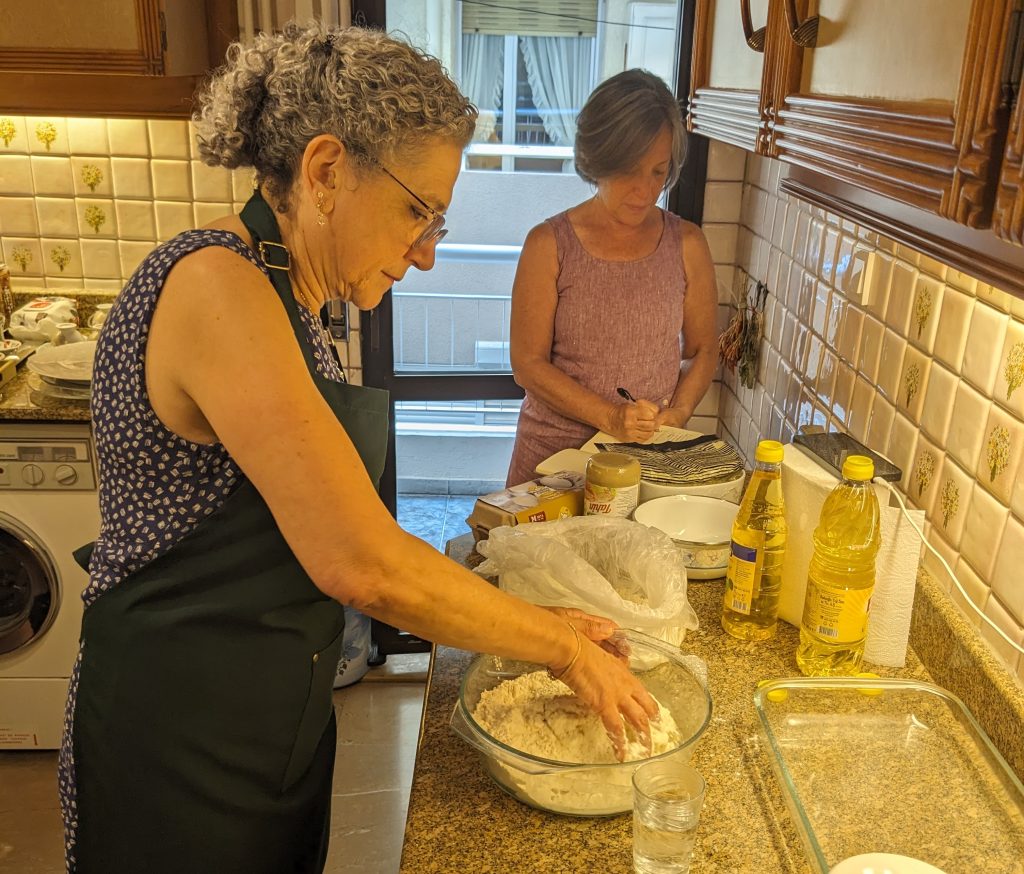
Similar to what we experienced with Luna and Simone on the Princess Islands, we found ourselves in a festive cooking and baking workshop where our teachers were eager and proud to share with us one of the strong backbones of their heritage, their food. We started out with making the home-version of boyoz. Katya was our teacher and we were told she was one of the rare home bakers of this pastry. We made a stiff dough with flour, water, sunflower oil, a bit of vinegar, and salt. After kneading the dough, we split it into little pieces which we pressed into small circles and let rest in oil. As they rested, Katya made the fillings—a savory one with potatoes and Tulum cheese and another slightly sweet one with tahini and sugar.
After the dough rested, we stretched each piece with our hands on the counter until it was relatively thin, almost see-through, added the filling and formed a package. They were looking very different from the boyoz we experienced that morning. Katya was a fun, assertive teacher, and didn’t shy away from correcting us as we tried to emulate what she was showing us.

Using the same potato filling, Ester showed us how to make ojaldres, a savory pastry that uses strips of yufka (thin Turkish pastry dough) folded in an alternating pattern to form a triangular package. Once we had some trays of boyoz and ojaldres ready to bake, Lina took over to show us how to make Fongos (Izmir Ladiona dialect) or Sfongo (Istanbul Ladino dialect), which to us, seemed like a version of spinach frittata. Lina told us it was a favorite of her grandkids. For this dish, we combined blanched spinach with eggs, the Turkish Tulum and Kasar cheeses, stale white bread and milk, spread it into an ovenproof pan, and topped it with decorative dollops of a potato, cheese, and egg mixture before baking it in the oven.

After we put the last tray in the oven, we moved over to the dining room for our meal, or I should say, a lovely feast on an eloquently prepared table. In addition to what we made together, we had other Sephardic specialties in the spread: roska (meaning round)—a yeasted, round sweet bread with almonds and sesame seeds, typically prepared for celebrations such as bridal bath ceremonies and bar mitzvah breakfasts; crescent rolls with eggplant; huevos haminados, or baked eggs; and mustachudos (walnut delights), a spiced, sweet mixture of ground walnuts (sometimes almonds) and cookies (they used petit buerres), rolled in the shape of a mustache.
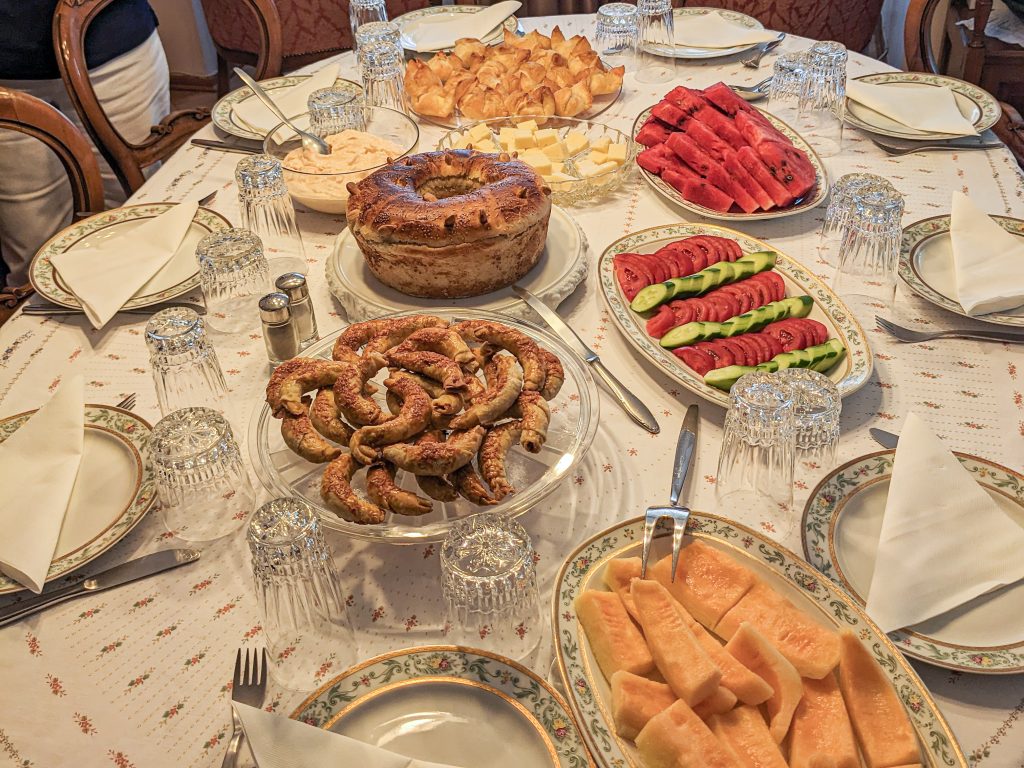
It was a different, refreshing pleasure to accompany these foods with subya, a sweet creamy drink made of melon seeds, traditionally used to break the Yom Kippur fast with, and commonly consumed during morning feasts and celebrations. With laughter, questions and answers, and more memories floating around, we finished our visit with some more Turkish coffee.
The next day, we had a walking tour with Nuket in the Kemeralti district, an area known for its rich Jewish heritage, including several synagogues. The narrow streets lined with vendors, from bakeries to textile shops, helva makers to fish mongers, were bustling with activity. With a taste of what Izmir-ians get to eat in our mouths, the sights and sounds as well as the stories we got to hear from Nuket, I would like to imagine we got a glimpse of what life might have been like in this culturally rich part of this beautiful sea-side city.
This concludes our series of blog posts about our trip to Turkey. What’s next? We are now dedicating our team to the holiday baking for our Ann Arbor community. In the new year, we’ll continue our research and plan to add some Sephardic baked goods to our repertoire.
Originally from the island of Cyprus, Hazim decided to immerse himself in the world of bread baking and all foods fully flavorful after a career in environmental engineering. He joined the Bakehouse team in 2016 with a focus on bread quality and innovation. You may find him at the bench with his baker friends rolling Farm dough, milling flours on our stone mills, teaching a Naturally Leavened Bread class at BAKE!, tasting breads, loudly (he calls it "passionately") elaborating on the benefits of whole-grain flours or temperature for sourdough baking, or stopping in his tracks to think about the next possible bread or improvement. Science is dear to him, and he loves windsurfing!! He was recently featured on Rise Up! The Baker Podcast with Mark Dyck talking about getting his start in baking, the tension of leaping into a new career, and working on a team where he can be his whole self.
